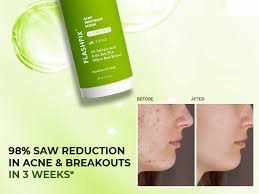
How to Use Salicylic Acid: The Complete Guide for Acne‑Prone and Oily Skin
If you struggle with oily, blemish-prone skin, you’ve likely encountered salicylic acid—one of the most trusted BHAs for clearing pores, softening dead skin cells, and controlling breakouts.
Salicylic acid’s molecular structure is smaller than AHAs like glycolic or lactic acid, allowing it to penetrate deeply and dissolve excess sebum and debris trapped inside pores.
Its oil-soluble nature makes it especially effective for cutting through clogged pores and reducing blackheads, whiteheads, and inflammatory blemishes when used properly.
However, because of its potency, overuse or incorrect application can strip the skin of essential oils and lead to irritation, dryness, or sensitivity—especially for dry or delicate skin.
In cases of dryness or severe sensitivity, skincare experts often advise steering clear of daily salicylic acid use, or incorporating it very gradually to build tolerance.
To learn more about how salicylic acid improves complexion and pore clarity, be sure to explore our dedicated article explaining its core skincare benefits.
What Is the Best Way to Use Salicylic Acid?
The ideal method depends on your skin type, existing routine, and specific concerns—products range from cleansers to toners to potent serums and leave-on exfoliants.
Salicylic acid cleansers usually contain low concentrations, which makes them ideal for daily use, especially when you’re just getting started with BHA exfoliation.
Face washes with salicylic acid rinse off quickly, reducing contact time and minimizing the risk of irritation while still helping to clear oil and bacteria buildup.
Exfoliating toners and chemical exfoliants with salicylic acid offer a step up in strength and efficacy—ideal for buffing away downtime debris and refining skin texture.
Because toners remain on the skin briefly, they can help remove residual dead cells and boost skin clarity without being overly aggressive when used occasionally.
For faster or more intense results, serums and moisturizers infused with salicylic acid offer higher concentrations, but they should only be used after your skin has acclimated.
These leave-on formulations work more effectively overnight to dissolve pore congestion and calm blemishes, provided you follow up with SPF the next morning.
Professional chemical peels with medical-grade salicylic acid are also available in clinics or dermatology offices, offering deep exfoliation and acne-targeted treatments in a controlled setting.
As always, discuss with a dermatologist if you’re unsure whether salicylic acid is appropriate for your skin—and to avoid unintended reactions or overexfoliation.
How Long Should You Leave Salicylic Acid on Your Skin?
How long to leave it on varies based on formulation—cleansers rinse off immediately, toners may stay on for a couple minutes, and serums remain until rinsed in your morning cleansing step.
Starting with cleansers or mild toners is a smart way to build up tolerance, since contact time is shorter and the concentration is generally lower.
As you progress to stronger leave-on products, it’s wise to begin with minimal frequency to avoid stripping your natural oils and compromising the skin barrier.
Always perform a patch test before applying any new salicylic acid product to your entire face—leave it undisturbed for 24 hours to check for discomfort or reaction.
How to Incorporate Salicylic Acid into Your Skincare Routine
Here’s a general outline for adding salicylic acid to your routine, depending on what type of product you choose to use.
1. Gentle Salicylic Acid Cleanser
Use daily or every other day, especially in the evening, to lift away oil, dirt, and bacteria without over-exfoliating.
This is ideal for oily or acne-prone skin and for beginners building their skin’s tolerance to BHAs.
2. Exfoliating Toner with Salicylic Acid
Apply after cleansing and pat dry, then leave for the recommended time (often around one to two minutes) before moving on to toning or serum steps.
Use this two to three times weekly to remove remaining dead skin cells and clarify dull or congested skin.
3. Salicylic Acid Serum or Treatment
Apply once your skin has built up tolerance—usually two to three times per week to start, gradually increasing frequency as tolerated.
Smooth it over clean, dry skin in your evening step, and follow with non-comedogenic moisturizer to maintain hydration.
4. Salicylic Acid Moisturizer or Cream
If designed for acne-prone skin, these can be used nightly once tolerance is established, helping prevent new blemishes while keeping skin hydrated.
Serums and moisturizers should always be followed by SPF in the morning to protect freshly exfoliated, sensitive skin.
5. Professional Salicylic Acid Peel
Performed by a licensed practitioner, these often use higher concentrations to address stubborn acne, texture, or pigmentation in a single in-clinic session.
These treatments require aftercare and proper recovery, so follow your provider’s instructions carefully for the best outcome.
How Often Can You Use Salicylic Acid?
Gentle formulations, like cleansers or low‑percent toners, can often be used daily—typically morning and evening on oily or combination skin.
Once leave-on serums or moisturizers are introduced, start with minimal usage (one to three times per week) to avoid over-exfoliation.
Excessive use of strong BHA products can strip skin oils, compromise the moisture barrier, and lead to increased sensitivity or even new breakouts.
Pay attention to your skin’s reaction—if you notice tightness, flaking, redness, or itching, reduce frequency or switch to gentler formats.
Do You Need to Wash Off Salicylic Acid?
It depends on the type of product you’re using: cleansers and toners typically require rinsing or waiting a short time, whereas serums and leave-on treatments remain until your next cleanse.
Leave-on serums are most effective overnight because they stay on the skin and continuously dissolve blockages and clear pore debris.
Always rinse your face in the morning to remove residue before applying SPF and daytime skincare.
Key Benefits of Salicylic Acid for Acne‑Prone Skin
Pore Deep‑Cleaning: Salicylic acid penetrates into pores, dissolving oil and debris to prevent blackheads and breakouts.
Gentle Exfoliation: It lifts away dead skin cells without stripping the skin, revealing a smoother, brighter complexion over time.
Oil Regulation: Oil‑soluble BHA helps regulate excess sebum production, reducing shine and blemishes common in oily skin.
Anti‑Inflammatory Properties: Salicylic acid calms redness and irritation, making it helpful for inflamed acne or sensitivity.
Improved Texture: Consistent use can minimize rough patches and visibly refine surface texture.
Supports Other Acne Treatments: Salicylic acid enhances efficacy of topical acne actives—evening the playing field when paired with other treatments.
Why Some People Should Avoid Salicylic Acid Daily
If you have dry, sensitive, or eczema‑prone skin, frequent salicylic acid use may over‑strip your skin, causing barrier breakdown and irritation.
Those with rosacea or dermatitis should consult a dermatologist before use, as BHAs may exacerbate redness or sensitivity in these conditions.
Pregnant or nursing individuals should also seek medical advice, especially if using higher concentrations or leave-on formulations.
Tips for Safe Use
Always introduce salicylic acid gradually—don’t rush to daily use if your skin is unfamiliar with acids.
Choose a sunscreen with SPF 30 or higher every morning—even indoors—to protect BHA‑exfoliated skin from UV damage over time.
Use hydrating and barrier-supporting ingredients like ceramides, hyaluronic acid, and niacinamide to balance exfoliation.
Avoid layering with other strong actives on the same evening—alternate usage with retinols or acids to minimize irritation.
Patch test any new product for 24 hours before full-face use to prevent unexpected allergic reactions.
Final Thoughts on Salicylic Acid Use
Salicylic acid is one of the most effective and deeply researched ingredients available for oily, acne-prone skin—when used properly and thoughtfully.
Choose the right format for your tolerance level—cleanser, toner, serum, or moisturizer—and introduce it steadily into your routine to avoid damage.
With thoughtful use, salicylic acid can clear congestion, improve texture, regulate oil, and leave your complexion noticeably clearer and smoother.
Always listen to your skin—if irritation arises, back off or switch formats and supplement with moisture-supportive products for balance.
If in doubt or managing severe acne, consult with a board‑certified dermatologist to find the ideal product strength and routine for you.
Your skin deserves clear, balanced care—and salicylic acid could be the powerful ally your acne‑prone complexion needs with patience and consistency.


